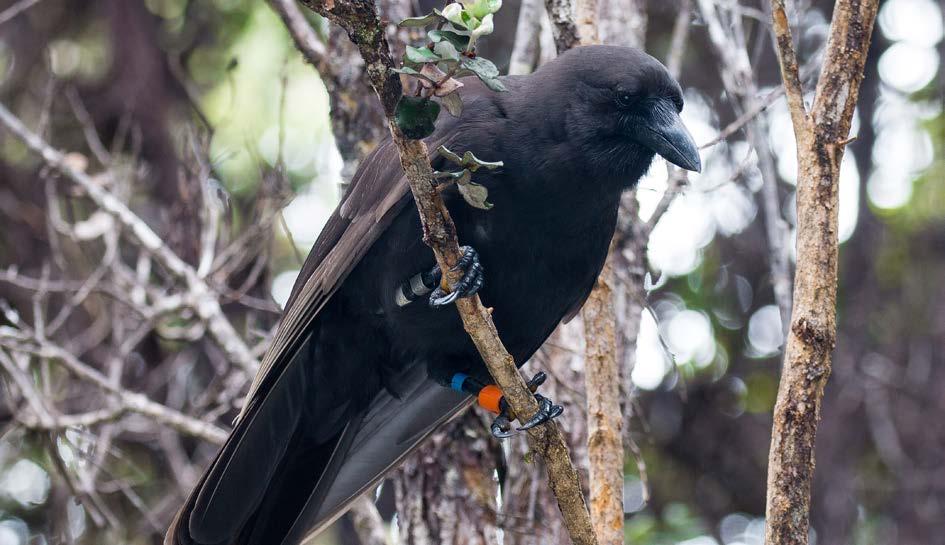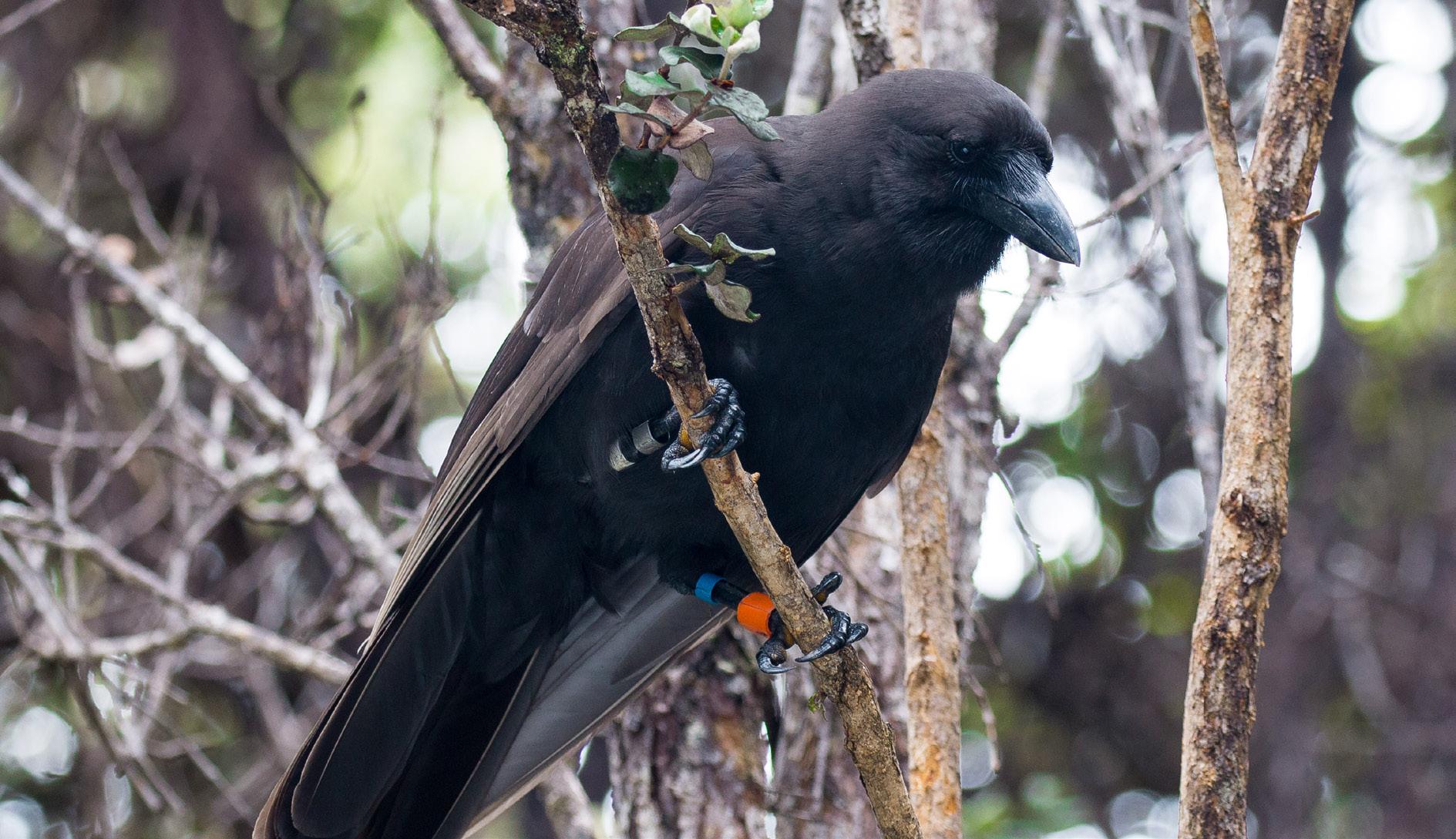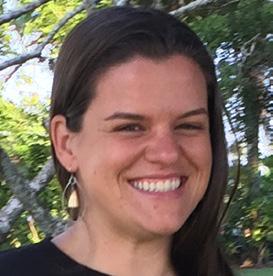
7 minute read
E Ho‘olā‘au Hou Ka ‘Alalā
May the ‘alalā thrive in their forest home
By Rachel Kingsley
Advertisement
Standing under the canopy of a large hāpuʻu tree fern I pause, I am on the slopes of Mauna Loa on Hawaiʻi Island. I hear the distant wailing cry of the bird I am searching for, an ʻalalā. He is off in the distance and it is unlikely I will see him today. I have been told to hear the cry of an ʻalalā in a forest space means you should leave. That voice is providing a warning that something isn'ʻt pono or now is not a good time.
These birds, the ʻalalā, are often likened to forest guardians protecting their spaces and those that reside in them. Their voice, silenced in our native forests for many years, holds meaning. To hear it again in this space is a privilege afforded by a reintroduction project for which I am employed.

As the mist rolls in it brings in a cool breeze. I put on my rain gear and dial in the code for another bird on the radio receiver I hold in my hand. I wait to hear the familiar beeps getting stronger as I turn the antennae pointing me in the next direction I need to hike. Setting off, I pick my way through the thick understory of native ferns and trees, smiling at the native berries I see along the way, food sources for the birds I am searching for.
These are images of special days I spent monitoring released ʻalalā in Puʻu Makaʻala Natural Area Reserve. We hope the people of east Maui will also have the privilege of hearing their voice in our forests someday soon, and this is the reason we reach out to the Kaupō ʻohana through Pōʻai Pili now as we consider where to next release ʻalalā.
ʻAlalā are a member of the Corvidae family of birds related to the American crow and common raven. Fossil remains indicate there were once five species of Corvids found across the Hawaiian islands, of which ʻalalā are unfortunately the last surviving members. ʻAlalā is historically known from Hawaiʻi Island, but it or a closely related Corvid was also present on Maui, indicated by remains found in a lava tube on leeward Haleakalā. ʻAlalā eat a varied diet of fruit, insects, and other protein and in doing so provide a critical role of seed dispersal for many of our native plants. These birds, once abundant are now critically endangered and extinct in the wild due to a combination of threats including habitat loss, introduced predators, and introduced diseases.
The last pair of ʻalalā were seen in the wild in 2002. Thanks to a conservation breeding program we still have ʻalalā today.
The story of ʻalalā has many twists and turns. In the 1990ʻs birds were released into habitat where the remaining wild population existed but were ultimately unsuccessful. After the captive population surpassed 100, The ʻAlalā Project, a partnership of the State of Hawai'i DLNR Division of Forestry and Wildlife, US Fish and Wildlife Service, San Diego Zoo Wildlife Alliance, and others formed a new release strategy.
Starting in 2016, reintroductions of ʻalalā occurred in Puʻu Makaʻala Natural Area Reserve on Hawai'i Island. Each released bird was monitored via a radio transmitter in the wild. Survival was initially high and attempts at breeding were observed, but after three years an increase in mortalities of the released birds led to the return of the remaining five individuals to captivity. There were a variety of reasons for the increased mortality but one was the depredation of ʻalalā by their natural predator the ʻio, Hawaiian hawk. Before future releases on Hawaiʻi Island, more must be known about ʻio and ʻalalā’s complicated relationship.
As the remaining birds were brought back into the conservation breeding facilities, The ʻAlalā Project partners started to plan the next steps for this species. The overall goal of this program is to create a self-sustaining wild population of ʻalalā. In order to accomplish this goal it is necessary to understand how and what ʻalalā need in the Hawaiian forests of today.

The ʻAlalā Project is proposing to release ʻalalā on east Maui where there are no breeding populations of ʻio. A decision about whether or not to release on Maui is anticipated to be made in spring 2023 after a thorough analysis on potential impacts to the natural and cultural environment. Wild ʻalalā are likely to interact with the natural environment in a multitude of ways, and we seek community guidance as to your concerns in this process. Overall, we are excited to see the health of mauka forests and watersheds benefit through their unique ability to disperse native seeds.
Guided by a structured decision-making process, community outreach, and field visits to six of the highest quality remaining habitat in Maui Nui, partners of the ʻAlalā Project have identified two potential release sites, Kīpahulu Forest Reserve and Koʻolau Forest Reserve, to analyze in an Environmental Assessment and Cultural Impact Assessment. The results of these assessments will frame the final decision.
The ʻAlalā Project wants to hear from the Kaupō community regarding their thoughts and concerns about the possibility for ʻalalā here. More information is available on The ʻAlalā Project website (www.alalaproject.org) and we encourage questions and comments to our email (info@ alalaproject.org) or by phone at 808-348-7898.
We expect completion of a draft Environmental Assessment this spring, and encourage comments to be submitted at that time as well. A great way to stay informed on the process is through our email list (ask us to add you). We are also seeking individuals who wish to share their ʻike and manaʻo with us in an interview to be included in the Cultural Impact Assessment.
Community involvement and support are crucial for this species’ success and help determine whether east Maui is a suitable release site.
The story of ʻalalā has been complicated but is not over. We know the recovery of ʻalalā will take many years but will benefit other species and the overall health of the forest ecosystem by restoring the ecological services these birds can provide. We not only hope to one day hear the voice of ʻalalā protecting their forests again but provide the same opportunity for the next generation.

Rachel graduated from the University of Wisconsin Stevens Point with a B.S. in Wildlife Ecology: conservation and research. She went on to earn a Master’s degree in Zoology from Miami University through their Global Field Program. Rachel began working her professional career working with Hawaiian birds in 2006 as an intern at the Keauhou Bird Conservation Center on Hawai‘i Island. For nearly 10 years Rachel worked as a Research Associate as part of the conservation breeding program staff before becoming the Outreach and Education Associate for The ‘Alalā Project in 2017. Rachel continues to work with The ‘Alalā Project and in 2020 joined the team at The Maui Forest Bird Recovery Project. Rachel enjoys connecting audiences to the native forest and manu friends that make Hawai‘i so unique and special.










